The Acer Nitro 5 Gaming Laptop Review: Absolutely AMD - Ryzen Plus Polaris
by Brett Howse on February 15, 2019 8:30 AM ESTSystem Performance
Acer offers both Intel and AMD powered versions of the Nitro 5, and there’s some significant differences in terms of CPU options due to the limited product stack AMD launched with Ryzen Mobile. The AMD powered Nitro 5 comes with a Ryzen 5 2500U processor, offering four cores, eight threads, and a maximum boost frequency of 3.6 GHz. Being a U series, the TDP is 15-Watts by default, though AMD offers a range of cTDP modes from 12-25 Watts. This is a rarely tapped feature on most laptops, but in this case it looks like Acer has put the Ryzen in cTDP up mode. We’ve reached out to Acer and AMD to confirm the TDP settings, but as you’ll see below this Ryzen 5 2500U performs well ahead of other we have tested.
AMD has recently announced the second generation Ryzen mobile processors, and the product stack is much wider, with a couple of new H series models which will expand the base TDP to 35 Watts. It would not be a shock to see this Acer updated when those are available.
This is the first Ryzen laptop we’ve tested though that’s been paired with a dGPU, so the Acer’s choice to go with the Ryzen 5 2500U isn’t as large of a step down from the 2700U as usual, since the big jump in the 2700U is the bigger Vega 10 GPU. Since any GPU task will be offloaded to the RX 560X, the iGPU performance tradeoff isn’t a concern.
For comparisons, we’ve included the Dell XPS 15 9560 because it came with a quad-core Kaby Lake and GTX 1050, which is the same type of components found in the other model of Acer Nitro 5. We’ve also included the Surface Book 2 15, which had a 15-Watt CPU paired with a GTX 1060, and the MSI GT75 Titan was included only because it’s the only other laptop we’ve tested with the most recent version of our gaming suite so far. If you’d like to compare the Acer Nitro 5 to any other system we’ve tested, please check out our online Bench.
PCMark
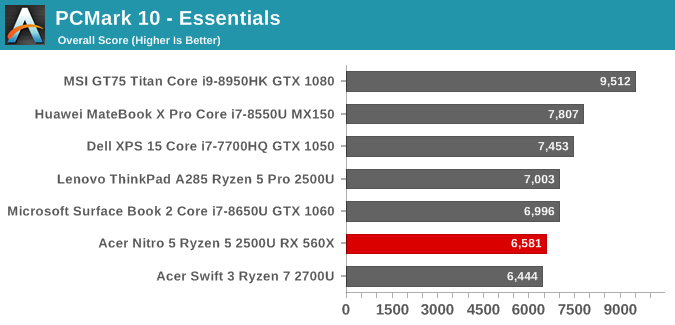
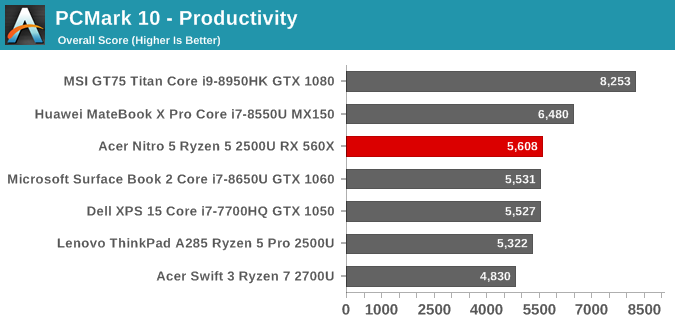
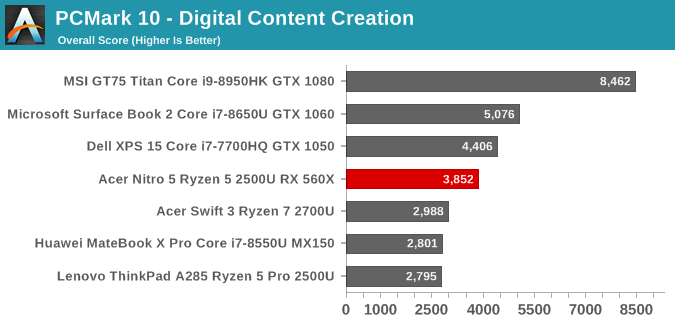
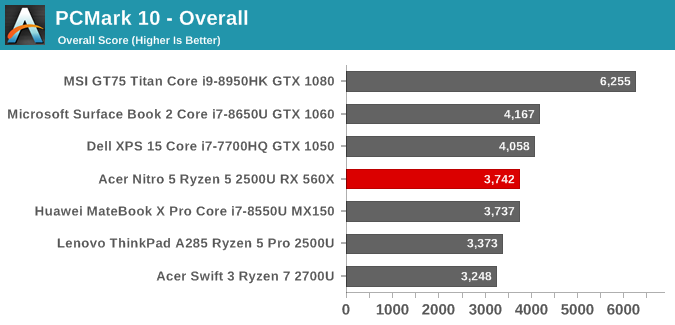
The Nitro 5 holds its own here, performing similarly to the Dell XPS 15, although its not quite able to keep up with a 45-Watt processor in all of the tasks on PCMark 10.
Cinebench
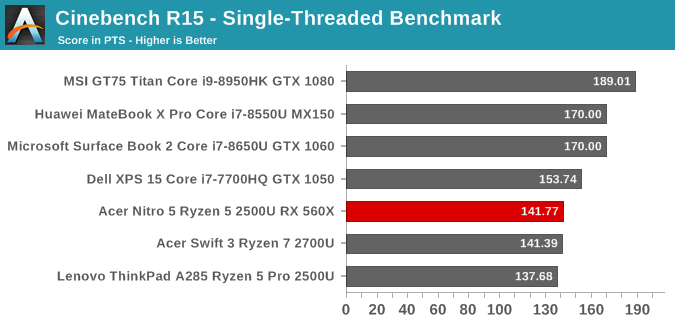
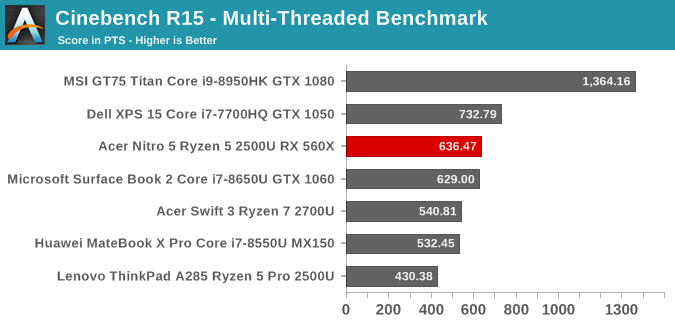
AMD’s Ryzen has always performed well in Cinebench, and continues to here as well. The extra cooling capacity of this gaming laptop lets the Ryzen stretch its legs, outperforming the same Ryzen 5 2500U we tested in the Lenovo ThinkPad A285 by a wide margin.
x264
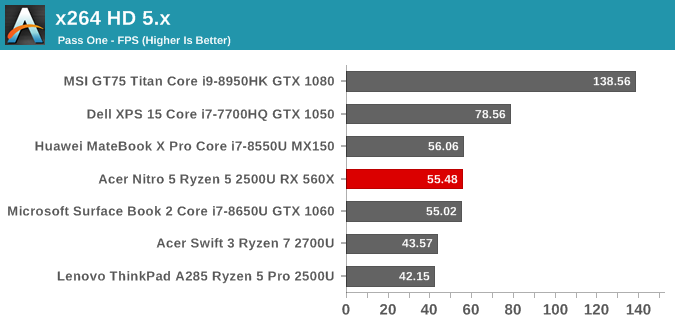

As with the previous tests, the Acer Nitro 5 performs quite well in our CPU based encoding test, but can’t quite match a quad-core Kaby Lake at 45-Watts. It’s still well ahead of the other Ryzen models we’ve tested though.
Web Tests
Web is one of the most important tasks for any system, but is also the least reliable way to check performance, since it is so heavily dependent on the browser, and of course browsers are updated continuously meaning even just using the same browser is more or less a snapshot in time.
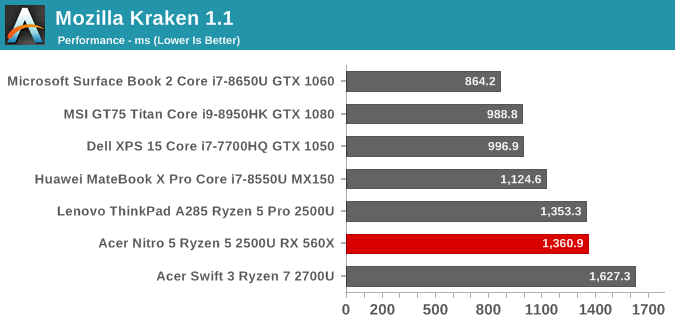
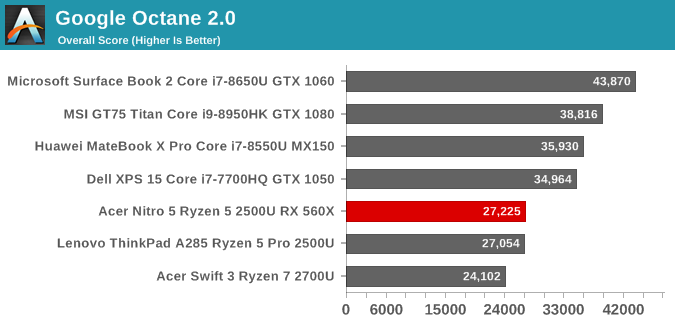
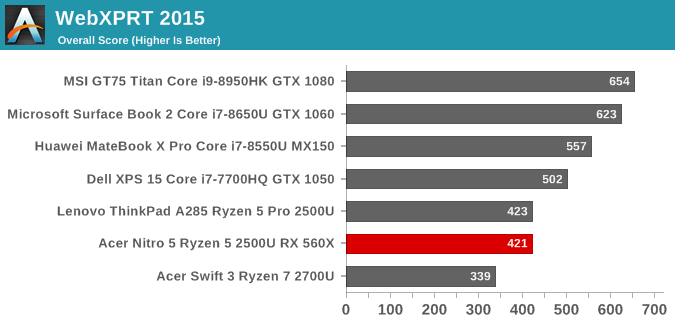
Web performance is one area where Ryzen struggles against the similar Intel Core products, most likely due to the effort Intel has put into their Speed Shift and how quickly the processors can ramp up to their maximum performance level, which is important in web because the tests tend to be short bursts of work.
CPU Conclusion
While not quite able to match the 45-Watt Intel quads, the Acer Nitro 5 with Ryzen 5 2500U still offers very solid performance, offering much more sustained performance than we’ve seen in any previous Ryzen laptop we have tested.
Storage Performance
Unless you buy the lowest-priced Nitro 5, Acer includes SSD storage, as well as a 2.5-inch HDD bay so that you can add extra storage if needed. With a 256 GB OS drive, there’s enough room for the OS and a couple of games though. Acer offers a SATA SSD in the Nitro 5, based on the Micron 1100.
Being a SATA based SSD, peak performance is certainly limited compared to NVMe drives, but it still offers orders of magnitude better performance compared to spinning drives. Considering the budget nature of this device, it’s excellent to even see an SSD, so if it has to be a SATA that is just fine.


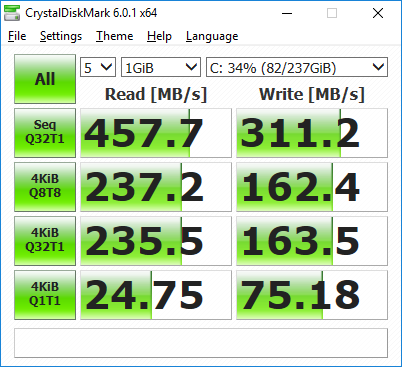








90 Comments
View All Comments
RSAUser - Friday, February 15, 2019 - link
Did you try and use the wattman auto undervolt for the graphics card?Does Radeon Chill work for mobile? Then fan noise should go down and battery should last longer.
Testing max fps is bad, don't even have minimum fps, let alone frame time plots to know how smooth it is.
jgraham11 - Friday, February 15, 2019 - link
Wow, did anyone notice that all the other processors are 45Watt meanwhile the AMD chip is only 15W!!! Holy crap!PeachNCream - Friday, February 15, 2019 - link
How can you miss that fact? The differences in TDP were pointed out multiple times in the article. You'd have to be in some serious skim mode to overlook it.cfenton - Saturday, February 16, 2019 - link
From the article: "Being a U series, the TDP is 15-Watts by default, though AMD offers a range of cTDP modes from 12-25 Watts. This is a rarely tapped feature on most laptops, but in this case it looks like Acer has put the Ryzen in cTDP up mode."So the AMD chip is 25w and the Intels are using 35w. It's a difference for sure, but it's not 15w vs 45w.
Brett Howse - Saturday, February 16, 2019 - link
The Intel ones are 45W - the 35W is an optional cTDP down mode.cfenton - Saturday, February 16, 2019 - link
My mistake. Thanks for the clarification.jgraham11 - Saturday, February 16, 2019 - link
For sure I believe you are correct, except for the MSI one which is 45watt.One thing I did find while looking at these specs for these Laptops:
Note all Newegg.com prices except the Acer AMD setup, as I could not find it. Prices are as of Feb 16 2019.
MSI GT75 TITAN GTX 1080 8 GB VRAM i9-8950HK sells for $4958.64
Huawei MateBook X Pro Intel Core i7 8th Gen 8550U MX150 sells for $1449.00
Dell XPS 15 core I7-7700HQ GTX 1050 sells for $1849.55
Microsoft Surface Book 2 Core i7 8650U GTX 1050 sells for $2279.00
This is not an Apples to Apples comparison in the least!
Meanwhile they are comparing it to a $699 AMD laptop....
Do you think that the extra $1k would provide a metal chassis which would result in better overall thermals hence better performance. And a better screen...
Anandtech please compare this one to another Acer Nitro 5 but with an Intel processor to actually make it a fair comparison.
Brett Howse - Saturday, February 16, 2019 - link
I explained why the comparison models were chosen in the review.fmcjw - Sunday, February 17, 2019 - link
Really? You don't take suggestions really well do you? I second jgraham11's suggestion because the thermal design makes each Intel Core a different beast.This is really an amateurish review, you can get as much info from a compact notebookcheck.com analysis. Who needs to be told that "Being a SATA based SSD, peak performance is certainly limited compared to NVMe drives, but it still offers orders of magnitude better performance compared to spinning drives?" Just show it in a table or chart. Are you being paid to hit a certain word count?
And you're unclear on whether adding a second RAM makes it dual channel, nor have you mentioned that you tried to see if Dual Channel is supported, but rather stuck to whatever configuration the company sent you.
Calin - Monday, February 18, 2019 - link
For spinning versus solid state hard drive performance, you have plenty of comparisons - when the transition took place, 5 or so years ago. Today's SATA SSD's aren't so much faster than the champions of 5 years ago (in typical end-user scenarios), but neither have the magnetic hard drive performance improved.